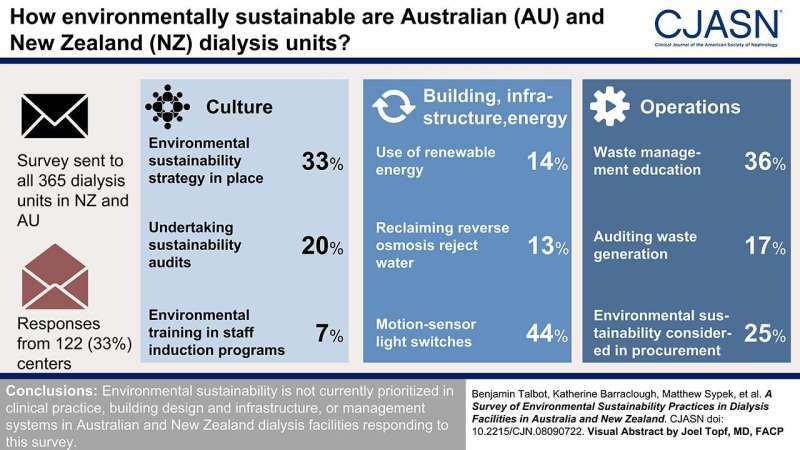Study assesses environmental sustainability practices in dialysis facilities

Health care is a significant contributor to greenhouse gas emissions that impact climate change. In fact, if the global health care sector were a country, it would be the fifth-largest emitter on the planet. And within health care, dialysis programs contribute disproportionately, with high resource consumption and waste generation. A recent study published in the Clinical Journal of the American Society of Nephrology examined the environmental sustainability practices of dialysis facilities, providing insights into where improvements could be made.
For the study, Benjamin Talbot, MBBS (The George Institute for Global Health) and his colleagues sent an online survey to the heads of all dialysis facilities in Australia and New Zealand between November 2019 and December 2020. Responses were received from 132 dialysis facilities, representing 33% (122/365) of dialysis services within Australia and New Zealand. Most responses were from public satellite facilities (40%), in-center dialysis facilities (25%) and co-located dialysis and home therapies facilities (21%).
Opportunities for improvement in environmental sustainability practices were identified in three domains:
- Culture—A minority of facilities reported having an environmental sustainability strategy in place (33%) or undertaking sustainability audits (20%). Only 7% reported the inclusion of environmental training in staff induction programs.
- Building design, infrastructure, energy use—Few facilities reported using renewable energy (14%), reclaiming reverse osmosis reject water (13%), or motion-sensor light-switches (44%).
- Operations—A minority of facilities reported having waste management education (36%), auditing waste generation (17%), or considering environmental sustainability in procurement decisions (25%).
"We have established a baseline of environmental sustainability practices in dialysis facilities in Australia and New Zealand, however, only 33% of dialysis facilities responded to the survey, which suggests that environmental sustainability is not a priority for most dialysis facilities. The responses to the survey regarding dialysis practices confirmed this further and demonstrate numerous areas where improvements can be made," said Dr. Talbot.
"As health care professionals, we have a duty to advocate for our patients and protect our planet. Dialysis is a life-saving treatment but it has a huge environmental cost, and we must all work together to find ways to reduce its impact."
The article, titled "A Survey of Environmental Sustainability Practices in Dialysis Facilities in Australia and New Zealand," was published on November 11, 2022.
More information: Benjamin Talbot et al, A Survey of Environmental Sustainability Practices in Dialysis Facilities in Australia and New Zealand, Clinical Journal of the American Society of Nephrology (2022). DOI: 10.2215/CJN.08090722




















